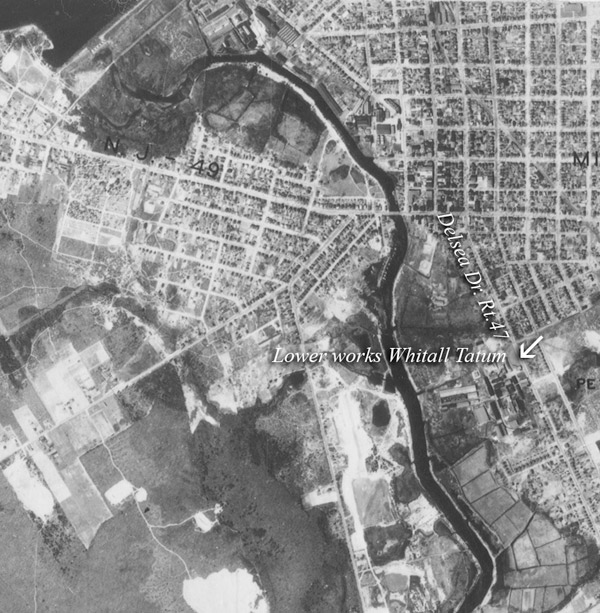Debra A. Barsotti
Research Journalist
Citizens United to Protect the Maurice River
and Its Tributaries, Inc.
The Maurice River Reaches Project
Lower Works
Reach #5
Half-pint, pint, quart, half gallon - and other "in-between sizes," colored aqua and amber and cobalt blue. Canning jars, laboratory glass, and "poison bottles." Today these glass containers that were made at the Lower Works are collectibles. (Poison bottles were specially designed and colored to alert the medical community and the public that the content of the container was "poison.") Glass insulators that were made at the site are also coveted by collectors. Serious collectors recognize the logos of the succession of owners, specifically Whitall Tatum, Armstrong, and Kerr, that manufactured their glass vessels on the site known as "the Lower Works."

One collector's page gives a historical sketch: “Whitall Tatum is the oldest glass manufacturing company in the United States, with operations commencing in 1806 as a window glass manufacturer. The company went through 14 ownerships throughout its history… Whitall Tatum was purchased by the Armstrong Cork Company in 1938 who continued to use the Whitall name and logo for a period of time…"
A collector of "poison bottles" noted that in 1969 the Armstrong facility " became part of the Kerr Glass Mfg. Co." This collector's web page says that "many poison bottles have been traced to them, with the most familiar being the cobalt quilted with stopper. Other colors are extremely rare, especially in teal and clear, they come in many different sizes."
 Lewis Hine's photos taken for the National Works Project Administration offer a glimpse in to the living conditions at the Lower Works. The nets are evidence that some of the residents fished the river in order to augment their living or to provide sustenance.
Lewis Hine's photos taken for the National Works Project Administration offer a glimpse in to the living conditions at the Lower Works. The nets are evidence that some of the residents fished the river in order to augment their living or to provide sustenance.
The information in several of Shirley Bailey's publications provides a timeline for the location known as "Lower Works."
"1832 - A small glasshouse which produced a combination of window glass and green glass was started by Frederick Schetter of Baltimore MD. Houses began to spring up around the plant area...soon known as Schetterville.
“1854 - Whitall Brothers & Co bought the works and merged it with the glassworks that was established by James Lee in 1806. This became known as the ‘Lower Works.’
“1857 - Firm became Whitall, Tatum & Co.
“1938 - The factory did not change hands again until 1938. At this time Armstrong Cork Co purchased it. They initiated many changes." Upper Works was dismantled. Operations were transferred to the "Lower Works" location. "During their ownership approx. $3M was spent remodeling and building new structures."
“1969 - …another change as Kerr Glass manufacturing Company purchased the plant."
 click to navigate the map "up".
click to navigate the map "up". click to navigate the map "down".
click to navigate the map "down". click to navigate the map "left".
click to navigate the map "left". click to navigate the map "right".
click to navigate the map "right". click to "zoom in" for a closer look.
click to "zoom in" for a closer look. click to "zoom out" to back away from the map.
click to "zoom out" to back away from the map. click to get back to the "default" map setting.
click to get back to the "default" map setting. click to learn more about that reach.
click to learn more about that reach.
